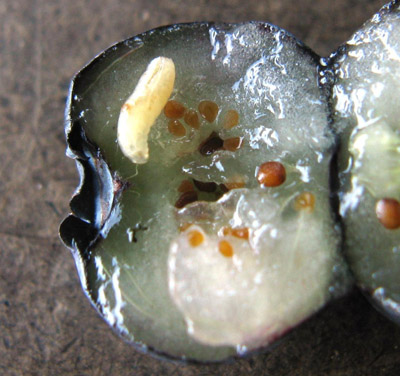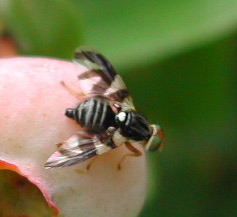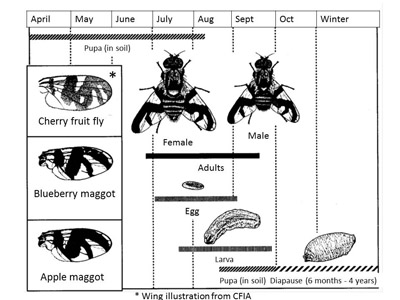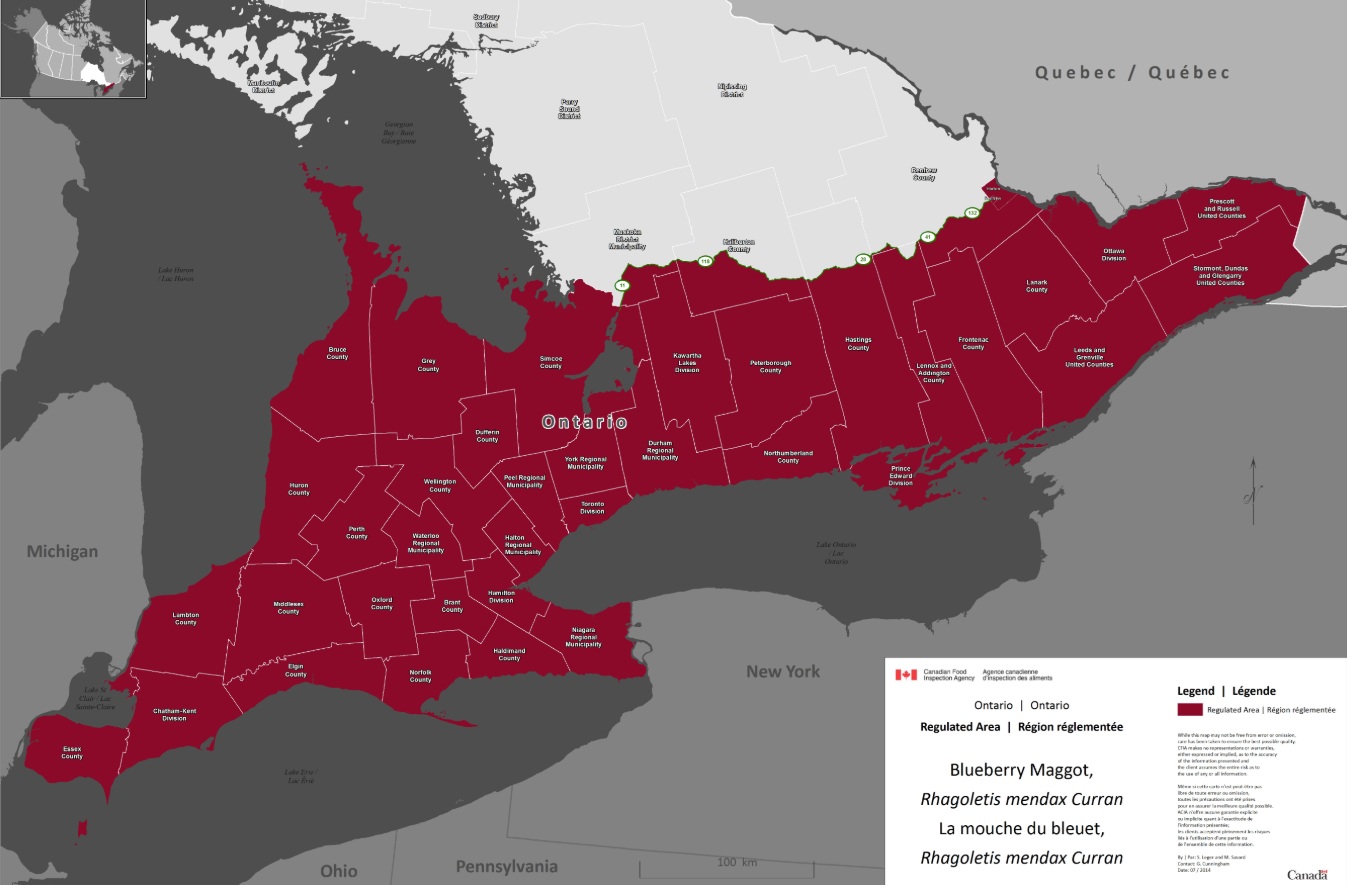Blueberry maggots
Learn how to identify blueberry maggot and prevent its spread.
Introduction
Blueberry maggot (BM) is a pest of both highbush and lowbush blueberries. It is native to eastern North America and has spread to parts of southwestern Ontario. Most of the highbush blueberry production in Ontario falls into an area where BM is present. Infested berries are unmarketable.
BM is a regulated pest in Canada. The Canadian Food Inspection Agency (CFIA) has developed requirements to prevent the spread of BM to non-infested areas. These requirements outline what growers must do when they are producing blueberries in infested areas or on infested farms.
Identification
The BM has 4 life stages:
- egg
- larva (maggot)
- pupa
- adult fly
BM is identified by checking for larvae in fruit and adults in traps. Other life stages are difficult to detect.
Larvae
Mature larvae are light-coloured and 8 mm in length, with no obvious head capsule (Figure 1). Their bodies are tapered or pointed at one end and blunt at the other. Two black mouth-hooks are visible on the pointed end, while six distinct brown breathing holes (spiracles) are found on the blunt end. These features are difficult to see without magnification.

Small BM larvae are easily confused with the invasive Spotted wing drosophila larvae (SWD) larvae. While BM are tapered at one end and blunt at the other, SWD are tapered at both ends. There is usually only one BM larva per berry versus several larvae per berry with SWD.
There are several other larvae that can be found in blueberries (Table 1).
| Insect pest | Head (other) | Legs (other) | Colour | Size of mature larva |
|---|---|---|---|---|
| Blueberry maggot | No head capsule (black mouth hooks) | No legs | Cream | 8 mm, pointed at one end, blunt at the other |
| Cranberry fruitworm | Brown head capsule | 3 pairs legs (plus abdominal prolegs) | Light green | 9–10 mm |
| Plum curculio | Brown head capsule | No legs | Cream | 7–9 mm, C-shaped |
| Spotted wing drosophila | No head capsule (black mouth hooks) | No legs | Cream | 5–6 mm, tapered at both ends |
Adult
The adult BM is slightly smaller than a housefly, about 4 to 5 mm in length. The body is shiny black with a white dot on the thorax. Females are slightly larger than males, with four pale lines on the abdomen (versus 3 in males) and a needle-like ovipositor (Figure 2). The most characteristic feature is the dark brown F-shaped pattern on their wings, which can be used to distinguish it from several other fruit flies (Figure 3 — inset photos). The wing pattern of BM flies is similar to that of apple maggot (AM). Other features used to distinguish between BM and AM adults include the length of the female’s ovipositor and colour patterns on the legs. These characteristics may be difficult to see so confirmation by a taxonomic specialist is required.

Period of activity
There is one generation per year (Figure 3). Adults emerge from overwintering pupae in the soil from late June through early July, depending on local weather conditions and soil moisture. Newly emerged adults are sexually immature. Prior to mating and egg-laying, adults must feed on nectar, honeydew and organic matter for 7 to 10 days. Females lay up to 100 eggs over a three-week period, sometimes into early September. Eggs are deposited under the skin of ripening blueberries beginning to colour. The developing maggot consumes the pulp of the berry, causing it to collapse. Larvae remain in the ripening fruit for several weeks and may be present at the time of harvest. Infested fruit may ripen and soften prematurely. Mature larvae exit the fruit and drop to the soil, where they pupate at depths up to 5 cm. A small percentage of pupae will remain in the soil for more than one year.

Blueberry maggot is a regulated pest
The CFIA conducts detection surveys for BM every year to identify new positive sites or townships. Areas are regulated by grower site or by township. A township is regulated if there is at least one infested natural (wild) site within the township or there are host plants growing within 500 metres of an infested grower site. Natural sites are not managed so these sites represent a continuous source for re-infestation of nearby grower sites. If there are no host plants located within 500 metres of an infested grower site then only that site is regulated, not the entire township.
At locations where BM has not been detected previously, the detection of a single fly on a trap can result in a stop shipment order from the CFIA, regardless of a grower’s spray program. Growers are ordered to stop all movement of blueberry fruit off the farm. This can happen during harvest.
Figure 4 shows a map of the counties and municipalities in Ontario where BM is regulated. All counties and municipalities in the southern portion of Ontario are regulated. The northern boundary of the regulated area runs from the northern municipal boundary of Horton and Renfrew, along Roads 132, 41, 28, 121, 118 and 11 and across the northern boundary of Simcoe County.
Blueberries can be shipped freely within the area indicated in red in Figure 4. If shipping outside this area to regions where blueberry maggot is not present, growers must be on a blueberry maggot certification program administered by the Canadian Food Inspection Agency.

Blueberry Certification Program
Where BM has been detected, growers can apply to be on a Blueberry Certification Program (BCP). This allows growers to move blueberries outside of the area. Before the beginning of the growing season and prior to approval into the BCP, first time participants need to be trained by the CFIA on the components of the program, including:
- biology and identification
- field monitoring
- cultural and chemical control measures
- fruit sampling and testing
- product grading to identify suspect fruit
To be part of this program contact the CFIA in your region. Applications must be submitted at least two weeks prior to the expected emergence of the adults and the approval must be renewed each year.
Monitoring
Monitoring for adult flies is the foundation for managing BM and is a key component in the BCP. Traps are monitored at least twice a week through harvest, either by the CFIA or by the grower. BM can be controlled by using an IPM program or an approved calendar spray program. In either situation, growers are required to apply insecticides when BM is caught on traps. This allows them to continue to ship blueberries unless the fruit is found to be infested with larvae. Fruit sampling is generally conducted by the CFIA.
Registered insecticides
There are several insecticides registered for control of BM. Most commercial growers are now spraying to control SWD through the berry ripening period. Some of the products used to control SWD also help control BM.
Cultural practices
Cultural practices such as sanitation, pruning and weed management can help reduce infestations on the farm. All unharvested berries should be removed from the field. Clean-picking and destruction of fallen berries or cull piles helps to destroy any larvae present in fruit and reduce re-infestation. Weeds provide sheltered areas for the adult flies. Pruning helps improve spray coverage.
Growers on the BCP must keep extensive records of all pest management activities. Audits are conducted to ensure compliance.
Accessible image description
Figure 4. Blueberry maggot regulated area:
- Brant County
- Bruce County
- Chatham-Kent Division
- Dufferin County
- Durham Regional Municipality
- Elgin County
- Essex County
- Frontenac County
- Grey County
- Haldimand County
- Haliburton County (portion south of Road 118)
- Halton Regional Municipality
- Hamilton Division
- Hastings County (portion south of Road 28)
- Huron County
- Kawartha Lakes Division
- Lambton County
- Lanark County
- Leeds and Grenville United Counties
- Lennox and Addington County
- Middlesex County
- Muskoka District Municipality (portion east of Road 11 and south of Road 118)
- Niagara Regional Municipality
- Norfolk County
- Northumberland County
- Ottawa Division
- Oxford County
- Peel Regional Municipality
- Perth County
- Peterborough County
- Prescott and Russell United Counties
- Prince Edward Division
- Renfrew County (portion south of Roads 28, 41 and 132 and within the boundaries of Horton and Renfrew)
- Simcoe County
- Stormont, Dundas and Glengarry United Counties
- Toronto Division
- Waterloo Regional Municipality
- Wellington County
- York Regional Municipality